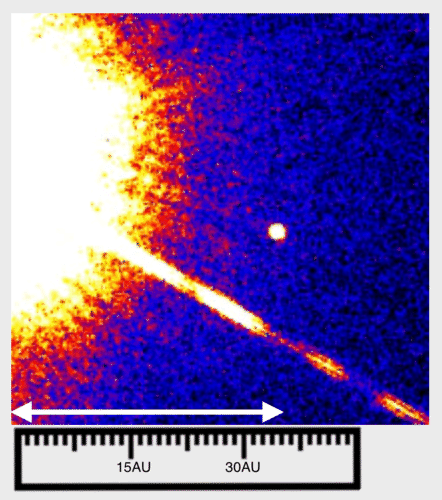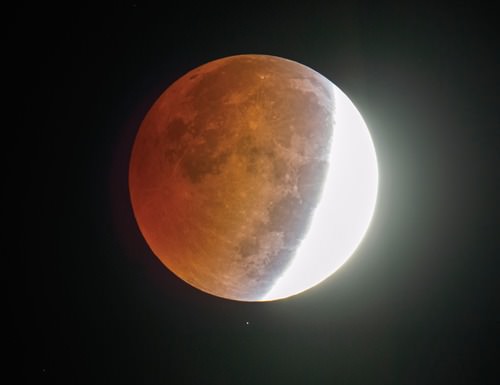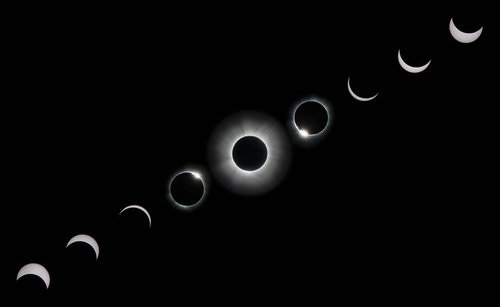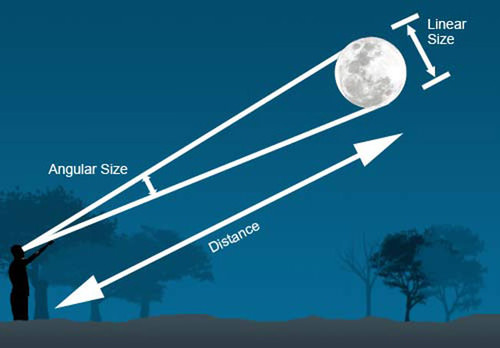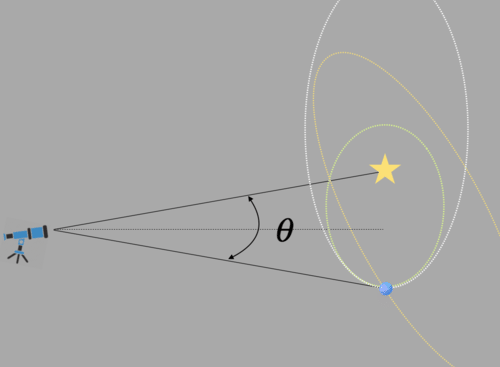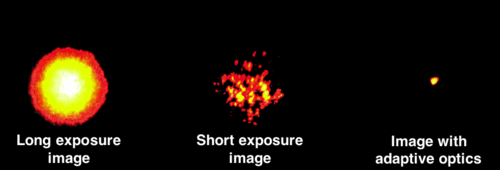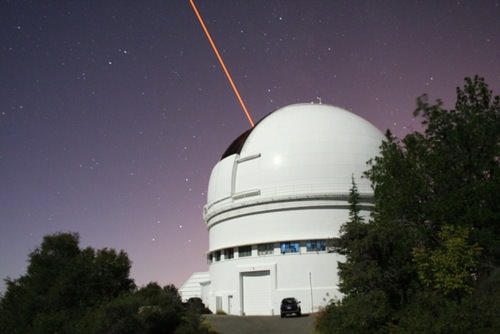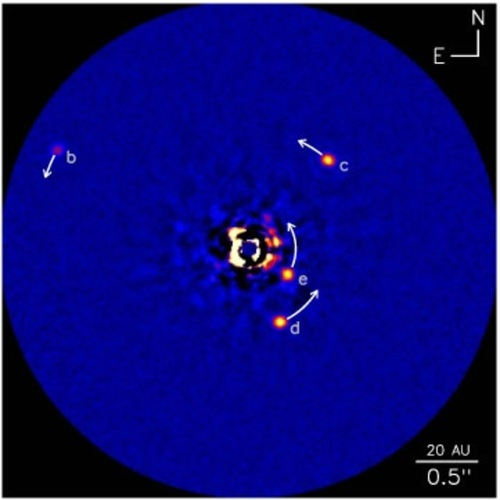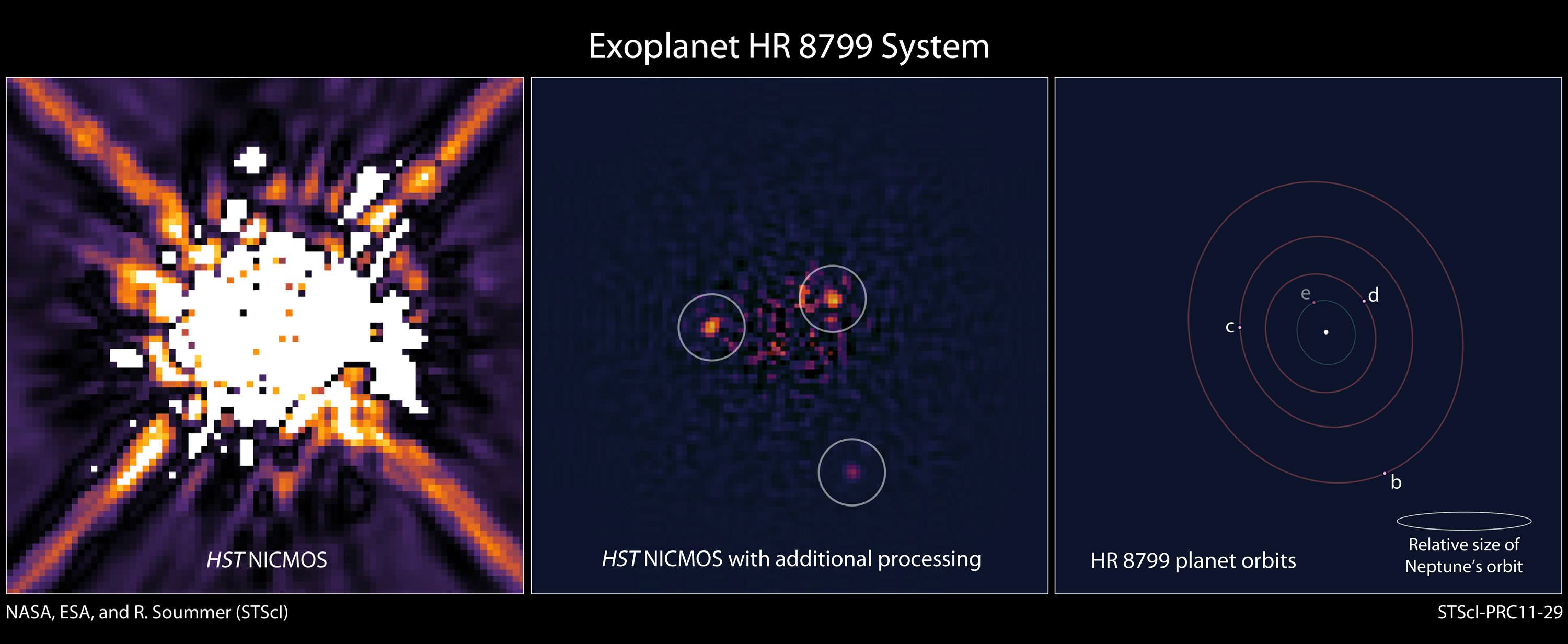10.2 直接成像
章节大纲
-
Just take a picture!
::照张相!Seeing is believing, so it would be ideal if we could simply point a telescope at a star and take a picture of the orbiting planets. This method is called direct imaging, and the biggest challenge is separating the light of the planet from the light of the star. The problem is that the planet is typically a billion times fainter and lost in the glare of the star.
::视觉是相信的,所以如果我们可以简单地将望远镜指向一颗恒星,并拍摄一幅轨道行星的图片,那将是理想的。这种方法被称为直接成像,最大的挑战是将地球的光与恒星的光分离。问题在于,行星通常比恒星的光线低10亿倍,在恒星的光线下消失。We might imagine that a directly imaged exoplanet would look like the small point of light next to the star Gliese 229 in the below, first taken in 1994 at the Palomar Observatory (left) and then observed with the Hubble Space Telescope (right) in 1995.
::我们也许可以想象,一个直接图像成像的外行星看上去会像下面的Glisee 229号恒星旁边的小光点,1994年首先在Palomar天文台(左侧)拍摄,然后在1995年用哈勃空间望远镜(右侧)观测。
These images show the star GJ 229A with a fainter companion, GJ 229B. The image on the left was taken with a ground-based telescope while the image on the right was taken with the Hubble Space Telescope. Why does the image from space have higher resolution?
::这些图像显示恒星GJ 229A和一个较弱的同伴GJ 229B。 左边的图像是用地面望远镜拍摄的,而右边的图像则是用哈勃空间望远镜拍摄的。 为什么来自空间的图像有更高的分辨率?The bright star in the above is GJ 229A. At a distance of about 20 light years, this star has the distinction of being one of the 100 closest stars to the Sun. GJ 229A is an M dwarf with about 60% the mass of our Sun and it is too faint to see with the naked eye. The much fainter companion, GJ 229B, was discovered at the Palomar Observatory in 1994 and is a "sub-stellar" object that is roughly 50 times the mass of Jupiter (or 0.05 times the mass of the Sun). GJ 229B does not have enough mass for hydrogen fusion to take place in its core; the radiated energy that we see comes from the fusion of deuterium to generate helium-3. Because hydrogen-fusion is the definition of a main sequence star, GJ 229B is not a star. This object is an example of a "brown dwarf" - it falls in between the upper mass limit for a planet (about 12 times the mass of Jupiter) and the lower mass limit for a star (about 70 times the mass of Jupiter). GJ 229B was the second brown dwarf ever to be discovered (the first was ) and the first brown dwarf to be discovered orbiting a star.
::上面的亮星是GJ 229A。 在大约20光年的距离里, 这颗恒星的区别是离太阳最近的100颗恒星之一。 GJ 229A是一颗M 侏儒,其质量约占太阳质量的60%,它太暗了,无法通过肉眼看到。 1994年在帕洛马天文台发现了更弱的同伴GJ 229B, 它是一个“ 子星” 对象,大约是木星质量的50倍(或太阳质量的0.05倍)。 GJ 229B 没有足够质量用于在核心中进行氢聚变; 我们所看到的辐射能量来自的聚聚聚融产生-3。 因为氢聚是主要序列星的定义, GJ 229B 不是恒星。 这个对象是“ 褐色矮星” 的一个例子, 它位于一个行星( 约12倍于木星质量的高度) 和一颗恒星( 约70倍于木星质量的低质量限) 之间。 GJ 229B 是第一次发现的第二个恒星的轨道。Naming stars and planets
::命名恒星和行星The naming of stars seems to be one of the more disorganized efforts by astronomers. Before the age of the internet (1990s), global communication was much less efficient, and astronomers worked at remote mountaintop observatories. A key task for astronomers in the early to mid 1900s was the measurement of sky coordinates and brightness of stars. Naturally, the brightest stars were cataloged independently by several different astronomers. For example, the bright star Tau Ceti has 45 different identifiers: in the Harvard Revised Bright Star Catalog it is called HR 509, in the Henry Draper catalog it is HD 10700, the Gliese Jahreiss catalog lists the star as GJ 71, and so on... The online site tracks this messy nomenclature, listing all of the star names and other information about individual stars for astronomers.
::恒星的命名似乎是天文学家组织得更混乱的努力之一。 在互联网时代(1990年代)之前,全球通信效率低得多,天文学家在偏远的山顶观测站工作。 天文学家在1900年代初至中期的一项关键任务是测量星体的星座坐标和亮度。 当然,最亮的恒星是由几个不同的天文学家单独编目。 比如, 明亮的恒星陶Ceti有45种不同的识别符号: 在哈佛修订过的星体目录中,它被称为HR 509, 在亨利德拉珀星目录中,它叫做HD 10700, Gliee Jahreiss编目将恒星命名为GJ 71,等等... 在线网站追踪了这个混乱的术语,列出了天文学家的所有恒星名和其他关于单个恒星的信息。About half of the stars in our galaxy are gravitationally bound as binary stars that orbit a common center of mass. Some catalogs gave each of the stars its own number, while other catalogs designated the brighter star as "A" and the fainter star as "B." Sometimes, fainter components were discovered long after the catalogs were published, like GJ 229B. The discovers renamed GJ 229 as GJ 229A, and they called the fainter object GJ 229B. And sometimes there are 3 or more stars (A, B, C, and so on) that are gravitationally bound.
::银河系中大约一半的恒星被引力捆绑在一起,作为环绕一个普通质量中心的二进制恒星。有些目录给出了每个恒星的编号,而另一些目录则指定较亮的恒星为“A”,而较弱的恒星为“B”。有时,在目录公布很久之后,就发现了较弱的组件,如GJ 229B。发现将GJ 229改名为GJ 229A,它们称“较弱的天体”GJ 229B。有时,有3个或3个以上的恒星(A、B、C等)被重力捆绑绑在一起。When a planet is discovered around a star, it is designated with a lower-case letter, starting with "b" (there are no planets with the letter "a"). Planets are named in the order that they are discovered, which makes for a confusing alphabet soup of identifiers. If the companion to GJ 229 had been a planet instead of a brown dwarf, it would have been GJ 229b.
::当一个行星在恒星周围被发现时,它会以小写字母命名,从“b”开始(没有带有字母“a”的行星)。行星的名字按被发现的顺序排列,这就产生了一种混乱的字母识别符号汤。 如果GJ 229的同伴是一个行星而不是一个棕矮人,那它就会是“GJ 229b ” 。As a side note, if you decide to "name a star" through the , you won't find your star name in any database used by astronomers (the Star Register will keep your star name in a vault and pocket your $34.99).
::作为附加说明,如果你决定通过“命名一颗恒星”来“命名一颗恒星”,那么在天文学家使用的任何数据库中都找不到你的恒星名称(星登记册将把你的恒星名称保留在金库中,并口存34.99美元)。The picture of GJ 229B can help us to understand why direct imaging of a planet is so difficult. This brown dwarf companion is similar in size to Jupiter but emits 600 times more energy (thanks to the deuterium fusion in its core). The projected physical separation of GJ 229 A and B is similar to the Sun-Pluto distance in our solar system. If GJ 229B had been located at the Sun-Jupiter distance (5 AU), it would not have been visible in this image because it would have been completely lost in the glare of the host star.
::GJ 229B的图片可以帮助我们理解为什么对一个行星的直接成像如此困难。 这个棕色矮人伴侣与木星的大小相似,但释放了600倍的能量(多亏了核中的核聚变 ) 。 GJ 229 A和B的预计物理分离与太阳系中的太阳-紫外线距离相似。 如果GJ 229B位于太阳-朱拜特距离(5 AU ) , 它就不会出现在这个图像中,因为它会完全消失在主星的光环上。When we look at this picture, we can only see the projected separation of GJ 229 A and B onto the plane of the sky. We have no depth perception. This corresponds to a physical separation of about 35 AU (roughly the distance between the Sun and Pluto in our solar system).
::当我们看这张照片时,我们只能看到GJ 229 A和B的预计分离到天空的平面上,我们没有深度感知,这相当于约35个AU(太阳系中太阳和冥王星之间的距离)的物理分离。In the image of GJ 229A taken at the 200-inch Palomar telescope, the images of GJ 229A and B have been blurred by the atmosphere of the Earth. As a point of light from a distant star enters our atmosphere, it is bent in slightly different directions a thousand times each second by turbulent blobs in our atmosphere that have slightly different indices of refraction (caused by differences in temperature or pressure). To our eyes, this appears as the romantic "twinkling" of starlight, but with even a short 1-second exposure at a telescope, the recorded image of a star is smeared.
::在200英寸的帕洛马尔望远镜拍摄的GJ 229A图像中,GJ 229A和B的图像被地球的大气层模糊了。当远方恒星的光点进入我们的大气层时,大气中的动荡浮云每秒以略微不同的方向弯曲一千倍,而大气层中的扰动浮云的折射指数略有不同(由温度或压力的不同造成 ) 。 在我们的眼中,这看起来像星光的浪漫的“交错 ” , 但即使短短的一秒钟照射在望远镜上,所记录的恒星图像也被抹黑。The advantage of the Hubble Space Telescope (HST) is that the observatory is now above the Earth's atmosphere. However, even the HST image of GJ 229 is blurred by scattering of starlight on the telescope mirror and by the optics in the camera so that the final image is spread out into a speckled halo. Any planets would be comparable in brightness to the speckles and lost in the scattered image of the star. This tendency for the optical interfaces in an instrument to spread the light from a point source into a disk is called the "point spread function" (PSF) of the instrument. If the PSF of an instrument has been well characterized, the original underlying image can be recovered to some extent by post-processing with sophisticated software analysis.
::哈勃空间望远镜(HST)的优点是,观测台现已在地球大气层之上。然而,即使是GJ 229的HST图像也模糊不清,因为望远镜镜面上的星光散射和照相机中的光学显示使最后的图像散布到一个有斑点的光球中。任何行星的亮度都与颗粒相仿,并在恒星分散的图像中丢失。仪器中的光学界面将光从点源传播到磁盘的这种倾向被称为仪器的“点扩散功能 ” ( PSF ) 。 如果仪器的PSF具有良好的特征,那么通过先进的软件分析后处理可以在某种程度上恢复原始的原始图像。Measuring angular separations
::测量角分离A telescope points through angles of right ascension (parallel to the lines of latitude on the Earth) and declination (parallel to lines of longitude), reading angular positions on the sky similar to the way that a protractor works as shown in the below. A protractor measures in units of degrees. However, one degree on the sky is an enormous distance (the angular diameter of the moon is a half a degree). One degree can be subdivided into 60 arcminutes and one arcminute can be further divided into 60 arcseconds (notationally: ).
::望远镜通过右向升降角度(与地球纬度线平行)和弯角角度(与经度线平行),在天空上读取角位置,与下面所示的减速器工作方式相似。用度单位测量分数。然而,在天空上,一个度是巨大的距离(月球的角直径为半度)。一个度可再分为60弧分钟,一个弧分钟可进一步分为60弧秒(注意:1603600")。Telescopes measure the angular separation between objects projected onto the celestial sphere. How are angular separations related to physical separations?
::望远镜测量射入天球的物体之间的角分离。 角分离如何与物理分离相关?In astronomy, angular separations are the measurable quantity and can only be related to a linear or physical size if we know the distance to the object.
::在天文学中,角分离是可衡量的数量,只有我们知道与天体的距离,才能与线性或物理大小有关。Measuring Distances - the distance to the Moon
::测量距离-月球距离The moon is one of the closest objects to the Earth. How do we know the distance to the moon (~240,000 miles)? There are a few ways to figure this out. First, we know that the moon completes one orbit about the Earth in 29 days, so we could apply Newton's law of gravity to relate the orbital period and the mass of the Earth to the semi-major axis of the moon's orbit about the Earth.
::月球是接近地球的物体之一。 我们怎么知道月球的距离( ~ 240,000英里) ? 有几种方法可以解决这个问题。 首先, 我们知道月球在29天内完成一个环绕地球的轨道, 所以我们可以应用牛顿的引力定律 将轨道周期和地球质量与月球轨道的半主轴联系起来。(3rd century BCE) knew the diameter of the Earth and he used geometry and the angular size of the Earth's shadow relative to the apparent size of the moon during a lunar eclipse to estimate the physical size of the moon.
:三世纪BCE)知道地球的直径,他用地球阴影的几何和角大小与月蚀期间月球表面大小相比来估计月球的物理大小。
During a lunar eclipse, the Earth is between the sun and moon. The shadow of the Earth passes over the moon. We know the physical diameter of the Earth, and during a lunar eclipse we can see that the angular size of our planet is 2.5 times the angular size of the moon. How could you use this information to determine the distance between the Earth and the moon?
::在月食期间,地球在太阳和月亮之间。地球的阴影在月球上飘过。我们知道地球的物理直径,在月食期间,我们可以看到我们的星球的角体大小是月亮角体大小的2.5倍。你如何利用这些信息来确定地球和月亮之间的距离?The most precise measurement of the distance to the moon has been made with a . Retroreflectors were placed on the surface of the moon during the NASA Apollo and Soviet Lunokhod missions. By timing the round-trip light travel time between the Earth and moon, the distance to the moon can be measured with great precision.
::对月球距离的最精确测量是用一个反射器。在NASA 阿波罗和苏联卢诺克霍德飞行任务期间,反射器被置于月球表面。通过计算地球和月之间往返的轻型旅行时间,可以非常精确地测量月球距离。Coincidentally, the angular diameter of the sun is also a half degree (or 30 arcminutes), about the same as the angular size of the moon. The sun is physically 400 times larger than the moon, but it is also 400 times farther away than the moon. This fortuitous scaling means that when the moon passes between our line of sight to the sun, it will completely block our view of the sun for a few minutes (the below shows the Moon blocking out the sun during a solar eclipse ).
::巧合的是,太阳的角直径也是半度(或30弧分),与月亮的角尺寸大致相同。太阳的物理体积比月亮大400倍,但距离月球也远400倍。这个偶然的缩放意味着当月亮在我们视线之间向太阳穿透时,太阳的视线将完全屏蔽几分钟(下面显示月亮在日蚀时屏蔽太阳)。During a solar eclipse, the moon blocks out the light of the sun. The sun is 400 times larger than the moon, but also 400 times farther away. This coincidence means that the moon and sun have the same angular size. Chance alignments produce spectacular solar eclipses. Is the angular diameter of the moon slightly smaller or slightly larger than the Sun's?
::在日食期间, 月亮将太阳的光隔绝。 太阳比月亮大400倍, 但也比月亮远400倍。 这个巧合意味着月亮和太阳的角大小相同。 机会对齐会产生惊人的日食。 月亮的角直径比太阳小一点还是比太阳小一点?Distances to the stars
::恒星距离Measuring the distances to the stars cannot be done with laser ranging. Instead, we use trigonometric parallaxes (discussed in Chapter 3.1):
::无法用激光测距来测量与恒星的距离。 相反,我们使用三角对准轴(在第3.1章中讨论):Small angle approximation
::小角度近似We can use trigonometric functions from geometry to relate the angular size of an object to its physical size, once we know the distance. In the below, the sine of the angle subtended by the moon is defined as the linear size divided by the distance to the moon. Because this is a small angle, the sine is approximately the same as the tangent of this angle.
::我们可以使用几何的三角函数将物体的角大小与其物理大小联系起来, 一旦我们知道距离。 在下面, 由月球潜入的角的正弦被定义为线性大小除以月亮的距离。 因为这是一个小角度, 弦与这个角度的正弦差不多 。If we know the distance to an object, the angular size can be used to derive the physical or linear size. Is the angular size of an object proportional, or inversely proportional to the linear size?
::如果我们知道对象的距离, 角大小可以用来得出物理大小或线性大小。 对象的角大小是成比例的, 还是与线性大小反成比例的?You might worry that the sin or tan functions apply only to right angles, in which case we should be talking about in the image above. However, this factor of two drops out when the radius is used instead of the diameter. Sine and tangent functions can also be represented by expansions where the higher order terms drop out for small angles. When is a small angle:
::您可能会担心罪或黑白函数仅适用于右角度, 在这种情况下, 我们应该在以上图像中谈论 2 。 但是, 当使用半径而不是直径时, 以两点为退出系数。 顺弦和正切函数也可以通过扩展来表示, 以小角度退出较高顺序条件的扩展。 当 是一个小角度时 :Equation [1]
::[1] 等量[1]
Equation [2]
::a 角分离 [弧 =分离 [AU] 距离[parsec]α[arcsec]=r [AU]d[parsec]等量 [2]
The small angle approximation works for measuring distances with parallax angles. It also works for measuring angular separations. If we know the distance to an object, angular separations can be used to derive the physical diameter of objects, like the moon in the above. With a known distance, angular separations are also important for monitoring the orbits of binary star systems where both stars are bright enough to be visible. Since the two stars in a binary system are both at the same distance from our solar system, if that distance is known it is easy to convert the angular separation (in arcseconds) into a physical separation (measured in AU).
::角近似小角度用于用parllax角度测量距离。 它也用于测量角分离。 如果我们知道与物体的距离, 可以使用角分离来得出物体的物理直径, 如上面的月亮。 如果有已知的距离, 角分离对于监测双星系统的轨道也很重要, 因为两颗恒星都足够亮到可见。 因为二元系统中的两颗恒星都与太阳系的距离相同, 如果知道距离, 很容易将角分离( 弧秒) 转换为物理分离( 在 AU 中测量 ) 。Consider the case of a star at a distance of 10 parsecs with a directly imaged planet at a projected angular separation, . Solving equation 3 above, the physical separation of two stars (or a star and a visible planet) can be calculated:
::5 以上解析方程式3,可以计算两个恒星(或一颗恒星和一个可见行星)的物理分离:
::[分隔] * 角分离[arcsec] =物理分离[AU]
::10 分析=0"0.5=5非盟However, what does that physical separation tell us? As illustrated in the below, it is just the projected separation of the stars. Keep in mind that a single measurement of 5AU for the star-planet separation does not necessarily correspond to any parameter of the orbit. There are an infinite number of orbits that could pass through the planet position with the star at the focus of an elliptical orbit. Several measurements must be taken over time so that the time stamps on the changing positions can be used to derive the orbit of the planet.
::然而,这种物理分离告诉我们什么?如下文所示,它只是恒星的预测分离。记住,对恒星和行星平板分离进行5AU的单一测量不一定与轨道的任何参数相对应。有无限数量的轨道可以通过行星位置,恒星位于椭圆轨道的焦点。必须进行若干测量,以便利用变化位置上的时间戳来得出行星的轨道。If we know the distance to an object, the angular size can be used to derive the physical or linear size. Is the angular size of an object proportional, or inversely proportional to the linear size?
::如果我们知道对象的距离, 角大小可以用来得出物理大小或线性大小。 对象的角大小是成比例的, 还是与线性大小反成比例的?Adaptive Optics
::适应性光学To obtain direct images of exoplanets around nearby stars with ground based telescopes, a technique called (AO) has been developed to correct for the atmospheric twinkling of starlight. This idea was first proposed in 1953 by an astronomer, Horace Babcock. However, it took the significant technological development of the Reagan-era (popularized as the "Star Wars" initiative) to ultimately make AO viable for astronomy.
::为了直接获得附近恒星周围带有地面望远镜的外行星图像,已经开发出一种技术(AO)来纠正星光在大气中的交汇,这一想法最初由天文学家霍勒斯·巴布科克于1953年提出,但经过里根时代的重大技术发展(作为“星球大战”倡议而广为人知),才最终使AO对天文学具有可行性。AO combines optics, electrical engineering, and computers to correct for atmospheric distortion. In cases where there is more than one star in the field of view of the telescope, light from one of the nearby bright non-science stars is picked off with a mirror and sent to the AO system. Hundreds of actuators on a deformable mirror in the AO system are pistoned at high speed (thousands of Hertz) until the image of the star is concentrated into the smallest possible point of light. This counteracts the atmospheric distortion for all stars in the field of view, including the science star of interest. The below shows a series of images of the star Arcturus obtained with (left to right) a "long" exposure of a few seconds, a short exposure (a millisecond snapshot), and the AO-corrected image taken by Claire Max and her team at Lick Observatory . The AO-corrected image is similar to the image of the star that could be obtained from space.
::AO 组合光学、 电气工程和计算机, 以纠正大气扭曲。 在望远镜视野中存在不止一颗恒星的情况下, 附近一个明亮的非科学恒星的光被用镜子摘除, 并发送到 AO 系统中。 AO 系统中一个可变形的镜像上的数以百计的动画家被高速度活化( 千赫兹) , 直到恒星的图像集中到最小的光点 。 这抵消了包括科学明星在内的视觉领域所有恒星的大气扭曲。 以下显示一系列星体Arcturus 与( 左向右) 获得的“ 长时间” 接触, 短短时间接触( 毫秒快照) 和 Claire Max 及其在Lick 观测站的团队拍摄的 AO校正图像。 AO 校正的图像与从空间获得的恒星图像相似 。The image of the bright star Arcturus is obtained with an exposure of a few seconds, (left) a milli-second snapshot (middle), and the AO system at Lick Observatory (right). How is an adaptive optics system helpful to astronomers?
::光星Arcturus的图像是通过几秒钟的曝光获得的,(左)一毫秒的快照(中)和Lick天文台的AO系统(右)。适应性光学系统如何帮助天文学家?In some cases, there are not any bright stars in the field that can be used for the AO correction. In these cases, a laser guide star is created in the upper atmosphere. Pioneered at the Lick Observatory near San Jose, California, a sodium laser is strapped to the side of the telescope and fires a narrow beam of laser light whereever the telescope points. The laser light is absorbed by a thin layer of sodium atoms about 60 miles above the ground and these atoms re-emit the light, creating an artificial star for the AO system. In the below, some of the sodium laser light scatters off particles in the atmosphere, giving the appearance of a light saber.
::在某些情况下,田野中没有任何亮星可用于对AO进行校正,在这些情况下,在高层大气中创建了激光导星。在加利福尼亚州圣何塞附近的Lick天文台,先将钠激光绑在望远镜的侧面,并点燃一束狭窄的激光光束,无论望远镜的点点在哪里。激光光被离地面约60英里的一层稀薄的钠原子吸收,而这些原子又对光进行再造,为AO系统制造了一颗人造恒星。在下面,一些钠激光光在大气中散布粒子,使光剑出现。The sodium laser for the adaptive optics system at the 3-m Lick Observatory telescope. The laser is tuned to the absorption wavelength of sodium and is absorbed about 60 miles above the ground where it is re-emitted as an artifical star and used by the AO system to correct for atmospheric turbulence. Do you think that the AO laser would pose a danger for aircraft pilots flying in to SFO?
::3米长的Lick天文台望远镜用于适应性光学系统的钠激光,该激光与钠的吸收波长相适应,在地面上大约60英里处吸收,再作为人工恒星被吸入,并被AO系统用于纠正大气动荡。 你认为AO激光对飞往SFO的飞行员构成危险吗?Once the image has been corrected for atmospheric blurring by an adaptive optics system, astronomers can use a to block out the light from the star and expose long enough to see the faint orbiting planets. Conceptually, this is similar to trying to see a faint object (like a tennis ball, coming over the net) that is lost in the glare of the Sun. If you use your hand to cover the Sun, you can now see the tennis ball. If you were lucky enough to be in the path of totality under clear skies during the solar eclipse of 2017, then you had the perfect demonstration of how a coronograph works. In this case, the moon acted as a coronograph, allowing people to see stars close to the Sun in the "day" sky.
::一旦图像被一个适应性光学系统对大气模糊进行校正后,天文学家就可以使用一个能阻断恒星的光线并暴露足够长的时间来观察微弱的轨道行星。 从概念上讲,这类似于试图看到一个在太阳光亮中丢失的微弱物体(如网球,越过网)一样。如果你用你的手覆盖太阳,现在你就可以看到网球。如果你幸运地在2017年太阳日蚀期间在晴朗的天空下走着完整的路,那么你就能完美地展示一个日志如何工作。在这种情况下,月亮起到一个日志表的作用,使人们可以在“白天”的天空中看到离太阳很近的恒星。At the Keck telescope in Hawaii, astronomers used the AO system with a coronograph to detect four planets orbiting the star HR 8799. This star was selected as a good target because it is relatively close (about 40 parsecs from the Sun) and because the star is young (a mere 30 million years) so that any planets would also be young and luminous. Exoplanets are named with lower case letters beginning with "b" in the order that they are discovered. In the image below, planets b, c, and d were found in 2008 and planet e was discovered a few years later. It is challenging to find planets close to the star where the coronographic suppression of light is more difficult.
::在夏威夷的Keck望远镜上,天文学家使用带有日志的 AO 系统探测四颗行星环绕恒星 HR 8799。这颗恒星被选为一个很好的目标,因为它相对接近(来自太阳的约40个分析器),而且恒星年轻(仅3000万年),因此任何行星也年轻而光亮。外行星的大小写字母以“b”开始,顺序以“b”为序号。在下面的图像中,2008年发现了b、c和d行星,几年后又发现了e行星。在光的日志抑制更加困难的恒星附近找到行星是很困难的。Once the light from the planet host star has been suppressed in this way, it is possible to obtain spectra of the pale dots of light from orbiting planets. Spectroscopy of the four planets around HR 8799 has been carried out using the Project 1640 instrument on the Palomar telescope and shows variable amounts of absorption from water, carbon monoxide, carbon dioxide, and methane.
::一旦从行星主星发出的光以这种方式被抑制,就有可能从轨道行星上获取光点的光谱,利用Palomar望远镜上的1640号工程仪器对HR 8799周围的四颗行星进行了光谱分析,并显示水、一氧化碳、二氧化碳和甲烷的吸收量不一。Adaptive optics (AO) were used with a coronograph to suppress the light of young star, HR8799, and image four planets. The AO image is a snapshot, so it does not come with those nice arrows that indicate the orbital motion of the planets. How do you think this motion is determined?
::适应性光学(AO)用一个日志来压制年轻恒星(HR8799)和图像四行星的光。 AO 图像是一幅快照,所以它不会与那些显示行星轨道运动的漂亮箭头一起出现。你认为这个动作是如何确定的?HR 8799 was also observed with the Hubble Space Telescope. The image of HR 8799 with HST (the below) shows that this is not an easy discovery, even from space. Significant processing was required to recover the underlying image of the planets (middle, below).
::在哈勃空间望远镜中也观察到了HR 8799,HST中的HR 8799图像(下文)表明,即使从空间也不容易发现,需要大量处理才能恢复行星的基本图像(中间,下面)。HST observations of HR 8799 using the NICMOS camera (left) and image processing (center) to recover planets b, c, d. The right image shows the theoretical orbits based on ground-based coronography and AO images. Do you think that planets with distances similar to Neptune in our solar system would be visible from space without image processing (hint: see the relative scale in the lower right panel and image that super-imposed on the left image.
::HST对HR 8799的观测,利用NICMOS相机(左)和图像处理(中心)来回收行星b、c、d. 右图象显示基于地面日志和AO图像的理论轨道。你是否认为太阳系中距离与海王星相近的行星可以在不进行图像处理的情况下从空间可见(hint:见右下面板的相对比例和在左面图像上叠加的图像)。The search for exoplanets using coronographs is an exciting technique, and impressive technological advances in this field are permitting the detection of smaller planets located at smaller inner working angles (i.e., closer to the star). The goal for the next 20 years is to develop space-based coronographs on to image Earth-like planets around nearby stars and to obtain spectra to search for signatures of life.
::利用日志搜寻外行星是一种令人振奋的技术,该领域令人印象深刻的技术进步使得能够探测位于较小内部工作角度(即更接近恒星)的小行星。 未来20年的目标是开发天基日志以图示附近恒星周围的类似地球的行星,并获取光谱以寻找生命的特征。
